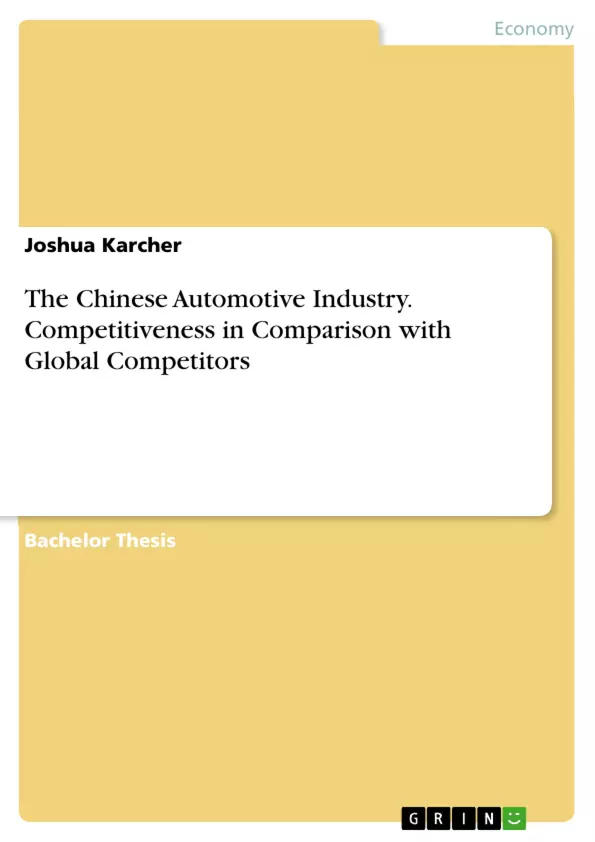The following thesis will answer the question: Did China develop a competitive domestic automotive industry?
Therefore, the rest of the bachelor thesis is structured as follows: The next section will give an overview of the history and the current market structure of the Chinese automotive industry. The second section contains a literature review of the theory and the empiricism of spillover effects originating from Joint Ventures with foreign enterprises and Foreign Direct Investment.
Subsequently, in the third section, the related literature is applied on the case of the Chinese automotive industry. The fourth section presents an application of the infant industry protection argument on the Chinese automotive industry. The fifth section includes an analysis of trade data in order to access the competitiveness of the Chinese automotive industry. Afterwards, there will be a conclusion and an outlook of the possible future developments of the Chinese automotive industry.
Since the beginning of economic reforms in China, protection, Joint Ventures, and Foreign Direct Investment played a significant role in the Chinese economic policy to promote industrial development. This is also the case for one of the global most important industries; the automotive industry. The automotive industry is a pillar industry with a vast number of linkages throughout the economy and plays a major role in driving China's economic growth and in ensuring employment.
The Chinese government followed the idea of an infant industry protection argument and imposed tariffs and quotas on automobiles and automobile components to promote the development of the automotive industry. Further, the policymakers strived for spillovers originating from foreign Joint Venture partners and Foreign Direct Investment.
Like other Chinese industries, the automotive industry experienced massive growth over the last four decades, making China, since 2008, the economy with the largest automobile output globally, surpassing Germany, the US, and Japan. However, there does not exist a single Chinese automobile brand, which can sell more than a few of its Chinese branded cars in the markets of developed countries.
This situation raises some questions about the real strength and competitiveness of the Chinese automotive industry.
Inhaltsverzeichnis (Table of Contents)
- 1 Introduction
- 2 History of the Chinese Automotive Industry
- The First Stage of Development
- Governmental Discontentment and Policy Measures of the 1990s
- The Second Stage of Development
- Period after the Great Recession of 2008
- Fostering of New Energy Vehicles and the Rise of Private Companies
- Current Structure of the Chinese Automotive Industry
- Component Suppliers Operating in the Chinese Automotive Market
- 3 The Special Role of Joint Ventures and Spillovers
- The Theory behind Spillovers
- Determinants of FDI Spillovers
- Actual Strength of Spillovers in China
- Actual Strength of Spillover Effects on Productivity
- 4 The Infant Industry Argument
- Theory Behind the Infant Industry Argument
- Infant Industry Argument applied to the Chinese Automotive Industry
- Infant Industry Protection with Local Monopolies
- Evaluating the Protection of the Chinese Automotive Industry
- 5 Assessing the Competitiveness of the Chinese Automotive Industry
- Exports as a Measure for Competitiveness
- Empirical Findings
- Comparison with Global Competitors
Zielsetzung und Themenschwerpunkte (Objectives and Key Themes)
This thesis aims to investigate the development of the Chinese automotive industry and assess whether it has become competitive. The analysis focuses on the historical development, key policies and structures, and the role of foreign investment and spillovers.
- The historical development of the Chinese automotive industry
- The role of government policies in fostering the industry
- The impact of joint ventures and foreign direct investment
- The effectiveness of infant industry protection measures
- The assessment of competitiveness based on export performance
Zusammenfassung der Kapitel (Chapter Summaries)
Chapter 1 introduces the research topic, outlining the importance of the Chinese automotive industry and the questions explored in the thesis. Chapter 2 provides a historical overview of the industry, examining key stages of development, government policies, and the emergence of new energy vehicles. Chapter 3 delves into the significance of joint ventures and spillovers, exploring theoretical underpinnings and their impact in the Chinese context. Chapter 4 examines the infant industry argument, its relevance to the Chinese automotive industry, and the role of local monopolies in protectionist measures. Chapter 5 assesses the competitiveness of the Chinese automotive industry through an analysis of export performance, comparing it to global competitors.
Schlüsselwörter (Keywords)
This thesis focuses on the Chinese automotive industry, its development, and competitiveness. Key terms include joint ventures, foreign direct investment, spillovers, infant industry argument, local monopolies, and export performance.
- Quote paper
- Joshua Karcher (Author), 2018, The Chinese Automotive Industry. Competitiveness in Comparison with Global Competitors, Munich, GRIN Verlag, https://www.grin.com/document/496939



